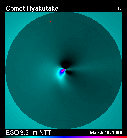Comet Hyakutake
Read More:

Dust Jets (ESO NTT Image)
This is the ESO WWW Home Page for Comet 1996 B2 (Hyakutake) which was the brightest comet in the sky since 1976. It passed within 15 million kilometres (0.1 AU) of the Earth on March 25, 1996, and reached its perihelion on May 1, 1996.
The latest, published (ground-based) observation is from October 24.45, 1996. On this date a magnitude of 16.8 was measured and no coma was seen anymore. (G. J. Garradd, Loomberah, N.S.W., Australia).
This page will be updated if new information and images — in particular from the ESO La Silla observatory — become available. However, the comet is now very faint and it is not likely that this will happen very often.
Enormous Ion Tail Observed! (April 2000)
In early April 2000, reports were published about some very interesting observations made with the Ulysses spacecraft. Travelling at a distance of no less than 570 million km from the comet's head, changes in the solar wind were observed that can be identified as interaction with the comet's ion tail. This is the longest ion tail ever observed from any comet and indicate that comets, in particular those that are much larger and more active that Hyakutake, may influence the conditions in interplanetary space much more than previously thought.
Various accounts of this discovery have been published, first in the Aptil 5, 2000, issue of Nature . Look also at:
"Old" News (August 4, 1997)
On IAU Circular 6696, issued on 8 July, 1997, M. J. Mumma and collaborators report: We searched for soft x-ray radiation from comet C/1996 B2 on 1996 Mar. 21-24 (r = 1.11-1.05 AU, Delta = 0.15-0.105 AU), using the Extreme Ultraviolet Explorer orbiting observatory. An image of soft x-rays in the range 70-180 eV was obtained with the Deep Survey Camera. It shows crescent-shaped emission with total luminosity of 1.0 x 10 25 photon/s within an aperture radius of 120 000 km. The emission is offset by 42 000 km sunward from the nucleus in the sky plane. Spectra were acquired over the range 7-70 nm (180-18 eV) and show both spectral lines and continuum emission.
On 28 July, 1997, a press release was issued by the University of Wisconsin (Madison) concerning a report to be published on 1 August, 1997, in the journal Science. It presents evidence that small, evaporating ice particles in the tail and surrounding the nucleus of Comet Hyakutake are producing most of the water and other gases seen from Earth.
The PR comments on the new results: Using the new 3.5 meter WIYN Telescope atop Kitt Peak, Ariz., Walter M. Harris and his colleagues captured some of the most detailed optical readings ever performed on a comet. Their findings imply that a previously detected swarm of several hundred billion marble-sized particles surrounding the relatively small nucleus of the comet is composed of icy material evaporating at a rate much greater than that of the nucleus. The observations suggest the halo of ice particles occupies a large volume of space around the nucleus, just 2.5 kilometers in diameter, and is constantly replenished by more particles blown off the nucleus.
This page has been elected
Planet Science Site of the Day (March 25, 1996)
and
Cool Site of the Nite (April 4, 1996).
